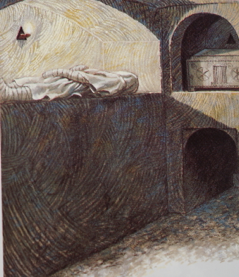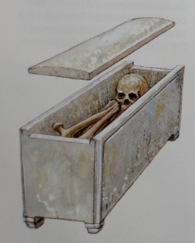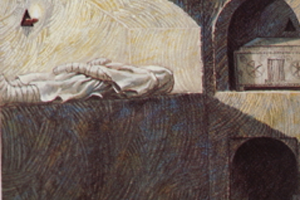Death and Burial at the Time of Jesus
N.B.: I am in the Holy Land at this time. As my travel schedule is heavy, I am republishing some articles about life in Jesus’ day. I hope you will enjoy reading (or re-reading) them as much as I did.
 The Jewish people took the burial of the dead quite seriously; this was the way a community paid their last dues to the one who had died. The Scriptures laid down quite firmly that no dead body was to be left unburied, even those of one’s worst enemies. Perhaps one of the stronger horrors that a Jewish person could envision was stated in Psalm 78: They have thrown the bodies of thy servants as food for the birds of heaven; wild beast feast on the corpses of the just.
The Jewish people took the burial of the dead quite seriously; this was the way a community paid their last dues to the one who had died. The Scriptures laid down quite firmly that no dead body was to be left unburied, even those of one’s worst enemies. Perhaps one of the stronger horrors that a Jewish person could envision was stated in Psalm 78: They have thrown the bodies of thy servants as food for the birds of heaven; wild beast feast on the corpses of the just.
The dead, therefore, had a right to ceremonial treatment. As soon as a man died, his eyes were to be closed, he was to be kissed with love, and his body washed (Genesis 50:1; Acts 9:37). In this washing, the body was anointed with perfumes. Nard was the most common of these, but myrrh was also used, as well as aloe.
In Jesus’ day, the custom was for the body to be wrapped elaborately in a shroud and the face covered with a special cloth called a sudarium. The hands and feet were tied with strips of cloth.
Once the body and been prepared, relatives and friends could come to the home to say goodbye for the last time. All of this happened quickly and burial usually followed within eight hours of death. In the hot climate, burial could not be delayed.
After this brief time for farewells, the body was carried to the grave in a kind of litter. There were no professional carriers; the person’s relatives and friends took turns carrying the body, as a sign of affection. Women led the ritual procession, which was quite noisy even in cases in which the death had been expected for a long time. All funeral processions were expected to have people wailing loudly and throwing dust in their hair; there would also be a flautist playing mournful music. Given these expectations, families often hired professional mourners to assist.
The Jewish people never cremated their dead; indeed, the idea horrified them, for they believed in the resurrection of the body.
Cemeteries were required to be at least fifty yards outside of any town or village.
The typical tombs of Jesus’ day were a kind of cave or excavation cut into a rocky cliff. Sometimes groups of families would share these burial areas. An opening into the side of a cliff might lead into a crypt of several rooms used by different families. There would be an outer chamber and an inner chamber, or at least a front and back are. In the outer chamber the body would be laid out on a bench or shelf cut into the rock. After final farewells, a large round stone, usually rolling in a groove, would be rolled into place to cover the entrance to the tomb.
These stones would often be whitewashed as a sign to passersby that the area was a gravesite. This was done because Jews incurred ritual uncleanness by coming into close contact with a dead body. This could be endured as an act of charity for a dead relative, but one would not wish to incur it for a stranger. The marked entrances thus served as a warning to stay clear.
Very poor people who could not afford a rock-hewn tomb or foreigners who had no land were buried in vertical shafts within designated fields. There is a reference to the purchase of the potter’s field in the Gospel of Matthew, which refers to the existence of these sorts of cemeteries for strangers who died and needed burial (Mat 27:7).
A brief repast would follow, which included the ritual drinking of wine and eating of the bread of mourning. For the very closest relatives (e.g., the spouse or child), mourning lasted for thirty days. Signs of mourning were wearing special clothing, not wearing phylacteries during prayer, and not answering greetings in the street.
 After about a year, family members would return to the tomb, collect the bones, and place them in a box called an ossuary. They would mark the box with identifying information and placed it in the back room of the tomb, where the bones of other relatives were stored. This is the source of the Jewish expression that after a man died, he “rested with his ancestors.” It also explains the concerns of the Patriarch Joseph: Then Joseph took an oath of the sons of Israel, saying, “God will visit you, and you shall carry up my bones from here” (Gen 50:25). Regarding the time when they left Egypt, Scripture says, And Moses took the bones of Joseph with him; for Joseph had solemnly sworn the people of Israel, saying, “God will visit you; then you must carry my bones with you from here” (Exodus, 13:19). Finally, Scripture says this: The bones of Joseph which the people of Israel brought up from Egypt were buried at Shechem, in the portion of ground which Jacob bought from the sons of Hamor the father of Shechem for a hundred pieces of money; it became an inheritance of the descendants of Joseph (Jos 24:32).
After about a year, family members would return to the tomb, collect the bones, and place them in a box called an ossuary. They would mark the box with identifying information and placed it in the back room of the tomb, where the bones of other relatives were stored. This is the source of the Jewish expression that after a man died, he “rested with his ancestors.” It also explains the concerns of the Patriarch Joseph: Then Joseph took an oath of the sons of Israel, saying, “God will visit you, and you shall carry up my bones from here” (Gen 50:25). Regarding the time when they left Egypt, Scripture says, And Moses took the bones of Joseph with him; for Joseph had solemnly sworn the people of Israel, saying, “God will visit you; then you must carry my bones with you from here” (Exodus, 13:19). Finally, Scripture says this: The bones of Joseph which the people of Israel brought up from Egypt were buried at Shechem, in the portion of ground which Jacob bought from the sons of Hamor the father of Shechem for a hundred pieces of money; it became an inheritance of the descendants of Joseph (Jos 24:32).
Thus Joseph rested with his ancestors. And so will we, until our bodies shall rise at the last trumpet.

